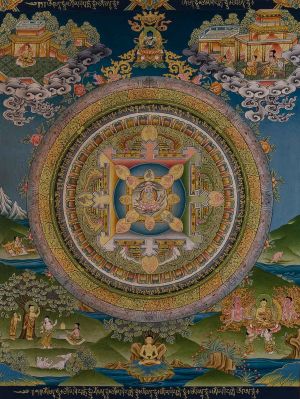Shishu-mandara
the daimandara 大曼荼羅 (great mandala), *sanmaya mandara 三昧耶曼荼羅, hou mandara 法曼荼羅 (Dharma mandala) and *katsuma mandara 羯磨曼荼羅; also abbreviated to shiman 四曼.
In Japan it is considered that the daimandara, in which the deities are shown in their physical form, represents the Buddhas' mystery of the body, while the sanmaya mandara,
in which they are represented by means of symbolic objects, symbolizes the Buddhas' mystery of the mind,
the hou mandara or *shuji mandara 種字曼荼羅, in which they are indicated by means of Sanskrit syllables, symbolizes the Buddhas' "mystery of speech",
and the katsuma mandara, in which they are represented by means of three-dimensional images, symbolizes the Buddhas' activities for the salvation of sentient beings.
The DAINICHIKYOU 大日経 (Sk: Vairocanabhisambodhi sutra/ Mahavairocana sutra; Taishou No.848) refers only to the daimandara, [[sanmaya
mandara and shuji mandara,
and there is no mention of the katsuma mandara.
The KONGOUCHOUKYOU 金剛頂経 (Diamond Peak Sutra; Sk: Sarvatathagatatattvasamgraha; Taishou Nos. 865, 882), on the other hand, describes all four types of
mandara, but the interpretation of the hou mandara and katsuma mandara differs from the above interpretation prevalent in Japan.
In Tibetan Buddhism too the four types of mandala are interpreted in accordance with the KONGOUCHOUKYOU, and it is therefore highly unlikely that the Japanese
interpretation was widely accepted in India.
The Japanese interpretation is based on the RISHUSHAKUKYOU 理趣釈経 (Taishou No. 1003) translated by Bukong (Jp:Fukuu 不空, Sk:Amoghavajra; 705-774), which won
wide currency in Japanese Esoteric Buddhism mikkyou 密教 ever since the time of *Kuukai 空海 (774-835).
